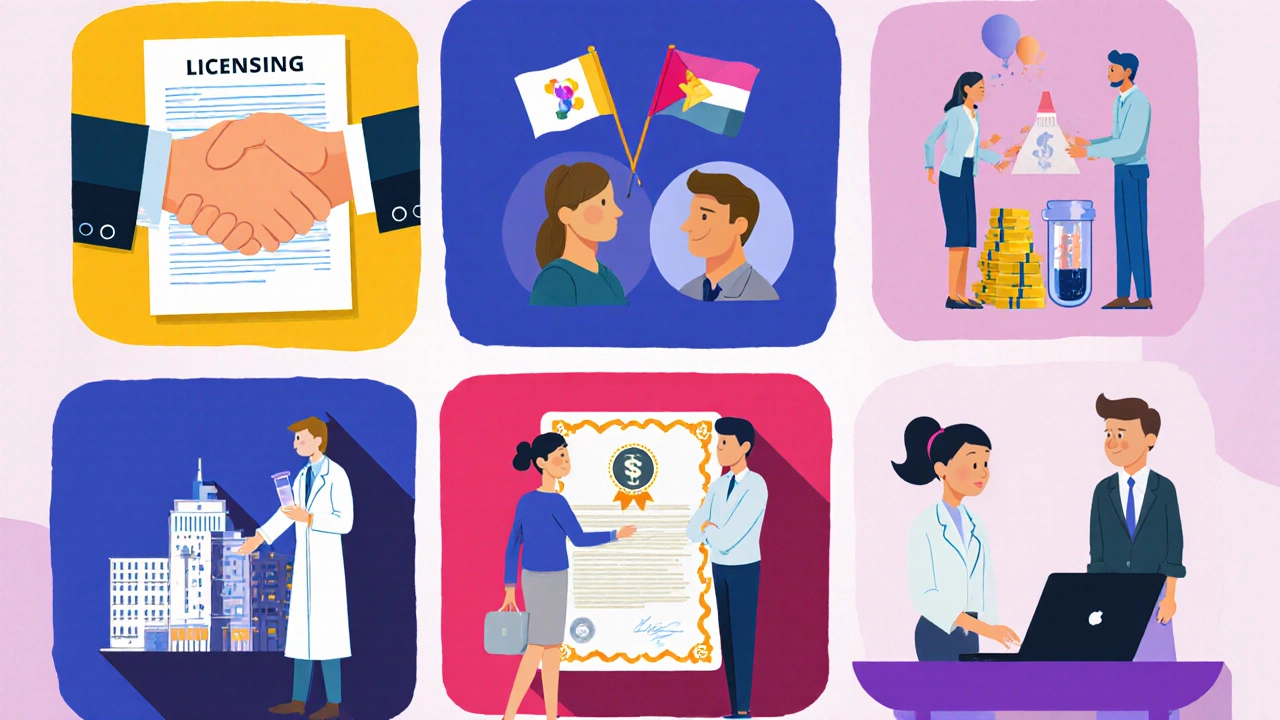Technology Transfer Type Selector
Recommended Technology Transfer Type
Key Takeaways
- Technology transfer moves ideas from labs to real‑world impact.
- There are seven widely recognized types, each with its own IP ownership and revenue model.
- Choosing the right type depends on the invention’s stage, market potential, and partner goals.
- Common pitfalls include vague agreements and missing royalty clauses.
- A quick comparison table helps you decide which route fits your project.
When universities or companies move inventions to market, Technology Transfer is the systematic process of transferring knowledge, inventions, or innovations from research institutions to commercial entities for development, production, and exploitation. It bridges the gap between scientific discovery and economic value, turning a lab breakthrough into a product you can hold in your hand.
What Exactly Is Technology Transfer?
At its core, technology transfer is about making research useful. It involves assessing an invention, protecting its intellectual property (IP), finding a partner who can scale it, and negotiating the terms that let both sides benefit. The process often starts in a university’s Technology Transfer Office (a dedicated unit that manages IP, negotiates agreements, and supports entrepreneurs), but corporate R&D labs run similar functions internally.
Why Does Technology Transfer Matter?
From a national perspective, effective technology transfer fuels Innovation Ecosystems (networks of universities, startups, investors, and government agencies that accelerate the commercialization of ideas). It creates jobs, attracts venture capital, and solves societal challenges-think of a new vaccine, a cleaner engine, or a low‑cost water sensor.
For researchers, it offers a pathway to see their work make a difference and often provides royalty income that can fund further studies.

Overview of the Main Types of Technology Transfer
Broadly, experts agree on seven core types. Each one answers a different need and uses a distinct contractual framework.
- Licensing (granting a third party the right to use, produce, or sell an invention while the inventor retains ownership)
- Spin‑off (forming a new company that owns the IP and is usually founded by the original inventor(s))
- Joint Venture (creating a separate legal entity jointly owned by the research institution and a commercial partner)
- Material Transfer Agreement (MTA) (a contract for sharing physical samples, such as biological specimens or nanomaterials, without transferring ownership)
- Research Collaboration Agreement (RCA) (a partnership where both parties co‑develop technology, sharing resources and IP rights)
- Patent Assignment (the outright sale of a patent from the inventor to a company, transferring all rights)
- Consulting/Service Agreement (providing expert knowledge or custom development services while retaining IP ownership)
Deep Dive into Each Type
1. Licensing
Licensing is the most common route for universities. The institution keeps the patent, while a company gets the right to commercialize it. Licenses can be exclusive (only one licensee) or non‑exclusive (multiple firms). Typical royalty rates range from 2% to 8% of net sales, often with an upfront payment to cover filing costs.
Key advantage: the research body retains control and continues to earn income. Drawback: negotiating terms can be lengthy, and enforcement of royalties may need legal resources.
2. Spin‑off
A spin‑off turns the invention into a standalone startup. Founders-usually the inventors-receive the IP, often with equity stakes from the university’s venture fund. Funding can come from angel investors, government grants, or corporate seed programs.
Benefit: full control over product direction and faster decision‑making. Risk: founders bear all financial exposure, and the university may see a delayed or reduced cash return.
3. Joint Venture
In a joint venture, both the research institution and a commercial partner contribute assets (IP, capital, facilities) to a new company. Ownership is split, commonly 50/50, though variations exist.
This model aligns incentives: both sides share risk and reward. However, governance can become complex, especially when academic timelines clash with market pressures.
4. Material Transfer Agreement (MTA)
MTAs govern the exchange of physical samples-think a new polymer or a gene‑edited seed. The sender retains ownership; the recipient can use the material for specific research purposes.
MTAs are essential in fields like biotechnology where sharing samples accelerates discovery while protecting the creator’s rights. Violations can lead to legal disputes, so clear scope and confidentiality clauses are a must.
5. Research Collaboration Agreement (RCA)
An RCA is a partnership that blends academic expertise with industry resources. Both parties co‑invest in R&D, and any resulting IP is usually shared according to pre‑agreed percentages.
RCAs work well for high‑risk, high‑reward projects-such as developing a new solar catalyst-where no single entity would fund the entire effort alone.
6. Patent Assignment
Here, the inventor sells the patent outright to a company. The buyer gains full control, including the ability to enforce the patent against infringers.
Assignments provide immediate cash for the research institution but forfeit any future royalty streams. They’re common when a large corporation wants exclusive rights to a breakthrough.
7. Consulting/Service Agreement
Under this model, the researcher offers expertise-such as algorithm development or prototype testing-while the client retains ownership of any new IP created during the engagement.
This approach keeps the inventor’s portfolio intact and can generate steady consulting fees, but it rarely leads to large‑scale commercial products unless followed by a later licensing deal.
Choosing the Right Type for Your Invention
Ask yourself four practical questions:
- Stage of Development: Is the technology at proof‑of‑concept, prototype, or market‑ready level?
- Market Complexity: Does commercialization require heavy capital, regulatory approvals, or specialized manufacturing?
- Control Preference: Do you want to retain ownership and steer direction, or are you comfortable handing over control for faster market entry?
- Funding Needs: Are you seeking upfront cash, ongoing royalties, or equity participation?
Early‑stage, high‑risk tech often fits a spin‑off or joint venture, while mature, low‑risk inventions typically go through licensing. If you simply need to share a sample for collaborative research, an MTA is the cleanest choice.

Common Pitfalls and Pro Tips
- Vague Scope: Define exactly which fields of use are covered. A “whole‑industry” license can unintentionally block future opportunities.
- Missing Milestones: Include development, commercialization, and reporting milestones to keep licensees accountable.
- Inadequate Royalty Structures: Use tiered royalties-higher percentages after a sales threshold-to align incentives.
- Neglecting International Protection: Secure patents in target markets before signing agreements.
- Ignoring Exit Clauses: Plan for termination rights if the partner fails to meet milestones.
By addressing these issues up front, you avoid costly renegotiations down the line.
Quick Reference: Comparison of Technology Transfer Types
| Type | IP Ownership | Revenue Model | Typical Use Case |
|---|---|---|---|
| Licensing | Owner retains patent | Upfront fees + royalties | Established product with market potential |
| Spin‑off | Transferred to new company | Equity, venture funding | Breakthrough requiring dedicated business |
| Joint Venture | Shared between parties | Profit sharing | High‑cost manufacturing or regulatory hurdles |
| Material Transfer Agreement | Sender retains IP | No direct revenue (research‑focused) | Sharing samples for collaborative studies |
| Research Collaboration Agreement | Joint ownership or split | Co‑development funds, milestones | Joint R&D projects |
| Patent Assignment | Buyer owns patent outright | Lump‑sum payment | Corporations seeking exclusive rights |
| Consulting/Service Agreement | Owner keeps IP | Consulting fees, possibly royalties later | Expert services without full transfer |
Next Steps for Researchers and Institutions
1. Conduct a thorough IP audit - know exactly what you own.
2. Talk to your Technology Transfer Office early; they can run a market assessment.
3. Draft a short list of potential partners based on sector relevance.
4. Use a template MTA or licensing agreement as a starting point, then customize.
5. Set clear milestones and reporting schedules in any contract.
Following this roadmap speeds up the journey from bench‑top to marketplace.
Frequently Asked Questions
What is the difference between licensing and a patent assignment?
Licensing lets a third party use the patent while the original owner keeps it, usually in exchange for royalties. A patent assignment transfers full ownership to the buyer, providing a one‑time payment but ending any future royalty income.
When should I consider a spin‑off instead of licensing?
If the technology needs a dedicated business model, substantial capital, or rapid product iteration, a spin‑off gives you full control and the ability to raise equity. Licensing works better for more mature inventions that fit within an existing company's portfolio.
Do material transfer agreements generate revenue?
Typically, MTAs are used for collaborative research and don’t include direct payments. However, they can pave the way for later licensing or joint‑venture deals that do generate revenue.
How can I protect my invention before signing a tech‑transfer deal?
File a provisional patent or a full patent application as early as possible. Keep detailed lab notebooks, use NDAs when discussing with potential partners, and limit public disclosure until protection is in place.
What are typical royalty rates for university‑licensed technologies?
Royalty rates usually fall between 2% and 8% of net sales, with higher rates for early‑stage products and lower rates once sales exceed a pre‑set threshold.



